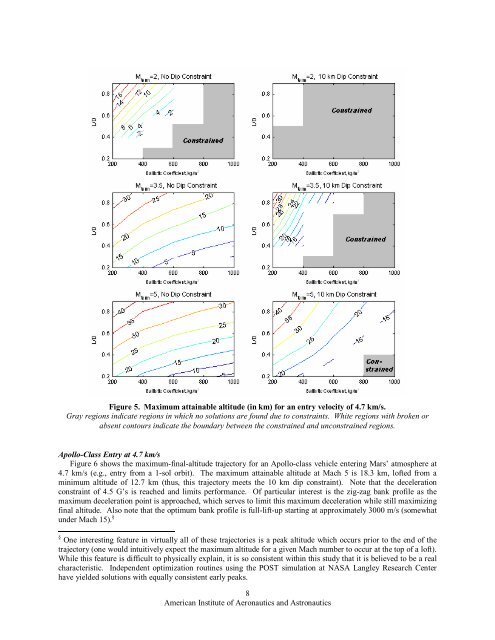Mars Entry Bank Profile Design for Terminal State Optimization
Mars Entry Bank Profile Design for Terminal State Optimization
Mars Entry Bank Profile Design for Terminal State Optimization
You also want an ePaper? Increase the reach of your titles
YUMPU automatically turns print PDFs into web optimized ePapers that Google loves.
Figure 5. Maximum attainable altitude (in km) <strong>for</strong> an entry velocity of 4.7 km/s.<br />
Gray regions indicate regions in which no solutions are found due to constraints. White regions with broken or<br />
absent contours indicate the boundary between the constrained and unconstrained regions.<br />
Apollo-Class <strong>Entry</strong> at 4.7 km/s<br />
Figure 6 shows the maximum-final-altitude trajectory <strong>for</strong> an Apollo-class vehicle entering <strong>Mars</strong>’ atmosphere at<br />
4.7 km/s (e.g., entry from a 1-sol orbit). The maximum attainable altitude at Mach 5 is 18.3 km, lofted from a<br />
minimum altitude of 12.7 km (thus, this trajectory meets the 10 km dip constraint). Note that the deceleration<br />
constraint of 4.5 G’s is reached and limits per<strong>for</strong>mance. Of particular interest is the zig-zag bank profile as the<br />
maximum deceleration point is approached, which serves to limit this maximum deceleration while still maximizing<br />
final altitude. Also note that the optimum bank profile is full-lift-up starting at approximately 3000 m/s (somewhat<br />
under Mach 15). §<br />
§ One interesting feature in virtually all of these trajectories is a peak altitude which occurs prior to the end of the<br />
trajectory (one would intuitively expect the maximum altitude <strong>for</strong> a given Mach number to occur at the top of a loft).<br />
While this feature is difficult to physically explain, it is so consistent within this study that it is believed to be a real<br />
characteristic. Independent optimization routines using the POST simulation at NASA Langley Research Center<br />
have yielded solutions with equally consistent early peaks.<br />
8<br />
American Institute of Aeronautics and Astronautics
















